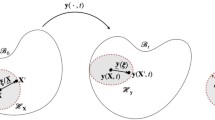Abstract
A generalization of the original peridynamic framework for solid mechanics is proposed. This generalization permits the response of a material at a point to depend collectively on the deformation of all bonds connected to the point. This extends the types of material response that can be reproduced by peridynamic theory to include an explicit dependence on such collectively determined quantities as volume change or shear angle. To accomplish this generalization, a mathematical object called a deformation state is defined, a function that maps any bond onto its image under the deformation. A similar object called a force state is defined, which contains the forces within bonds of all lengths and orientation. The relation between the deformation state and force state is the constitutive model for the material. In addition to providing a more general capability for reproducing material response, the new framework provides a means to incorporate a constitutive model from the conventional theory of solid mechanics directly into a peridynamic model. It also allows the condition of plastic incompressibility to be enforced in a peridynamic material model for permanent deformation analogous to conventional plasticity theory.
Similar content being viewed by others
References
Silling, S.A.: Reformulation of elasticity theory for discontinuities and long-range forces. J. Mech. Phys. Solids 48, 175–209 (2000)
Silling, S.A., Bobaru, F.: Peridynamic modeling of membranes and fibers. Int. J. Non-linear Mech. 40, 395–409 (2005)
Kunin, I.A.: Elastic Media with Microstructure I: One-dimensional Models, pp. 27. Springer, Berlin (1982)
Rogula, D.: Nonlocal Theory of Material Media, pp. 137–149 and 243–278. Springer, Berlin (1982)
Silling, S.A., Zimmermann, M., Abeyaratne, R.: Deformation of a peridynamic bar. J. Elast. 73, 173–190 (2003)
Weckner, O., Abeyaratne, R.: The effect of long-range forces on the dynamics of a bar. J. Mech. Phys. Solids 53, 705–728 (2005)
Dayal, K., Bhattacharya, K.: Kinetics of phase transformations in the peridynamic formulation of solid mechanics. J. Mech. Phys. Solids 54, 1811–1842 (2006)
Gerstle, W., Sau, N.: Peridynamic modeling of concrete structures. In: Li, Leung, Willam, Billington (eds.) Proceedings of the 5th International Conference on Fracture Mechanics of Concrete Structures, Ia-FRAMCOS, vol. 2, pp. 949–956 (2004)
Gerstle, W., Sau, N., Silling, S.: Peridynamic modeling of plain and reinforced concrete structures. In: 18th International Conference on Structural Mechanics in Reactor Technology (SMiRT 18), Beijing, China, SMiRT18-B01-2 (2005)
Gerstle, W., Sau, N., Silling, S.: Peridynamic modeling of concrete structures. Nucl. Eng. Des. 237, 1250–1258 (2007)
Silling, S.A., Askari, E.: Peridynamic modeling of impact damage. In: Moody, F.J. (ed.) Problems Involving Thermal-Hydraulics, Liquid Sloshing, and Extreme Loads on Structures, PVP-vol. 489, pp. 197–205. American Society of Mechanical Engineers, New York (2004)
Askari, A., Xu, J., Silling, S.: Peridynamic analysis of damage and failure in composites. In: 44th AIAA Aerospace Sciences Meeting and Exhibit, Reno, Nevada, AIAA-2006-88 (2006)
Kilic, B., Madenci, E., Ambur, D.R.: Analysis of brazed single-lap joints using the peridynamics theory. In: 47th AIAA/ASME/ASCE/AHS/ASC Structures, Structural Dynamics, and Materials Conference, Newport, Rhode Island, AIAA-2006-2267 (2006)
Bobaru, F., Silling, S.A.: Peridynamic 3D models of nanofiber networks and carbon nanotube-reinforced composites. In: Materials Processing and Design: Modeling, Simulation, and Applications – NUMIFORM 2004 – American Institute of Physics Conference Proceedings, vol. 712, pp. 1565–1570 (2004)
Silling, S.A.: Dynamic fracture modeling with a meshfree peridynamic code. In: Bathe, K.J. (ed.) Computational Fluid and Solid Mechanics 2003, pp. 641–644. Elsevier, Amsterdam (2003)
Silling, S.A., Askari, E.: A meshfree method based on the peridynamic model of solid mechanics. Comput. Struct. 83, 1526–1535 (2005)
Weckner, O., Emmrich, E.: Numerical simulation of the dynamics of a nonlocal, inhomogeneous, infinite bar. J. Comput. Appl. Mech. 6, 311–319 (2005)
Knowles, J.K.: Linear Vector Spaces and Cartesian Tensors, pp. 1–9. Oxford University Press, New York (1998)
Malvern, L.E.: Introduction to the Mechanics of a Continuous Medium. Englewood Cliffs, p. 359. Prentice-Hall, New Jersey (1969)
Warren, T.L., Silling, S.A., Askari, E., Weckner, O., Epton, M., Xu, J.: A non-ordinary sate based peridynamic method using an isotropic elastic-plastic constitutive model, (2007) (in preparation)
Author information
Authors and Affiliations
Corresponding author
Rights and permissions
About this article
Cite this article
Silling, S.A., Epton, M., Weckner, O. et al. Peridynamic States and Constitutive Modeling. J Elasticity 88, 151–184 (2007). https://doi.org/10.1007/s10659-007-9125-1
Received:
Accepted:
Published:
Issue Date:
DOI: https://doi.org/10.1007/s10659-007-9125-1




